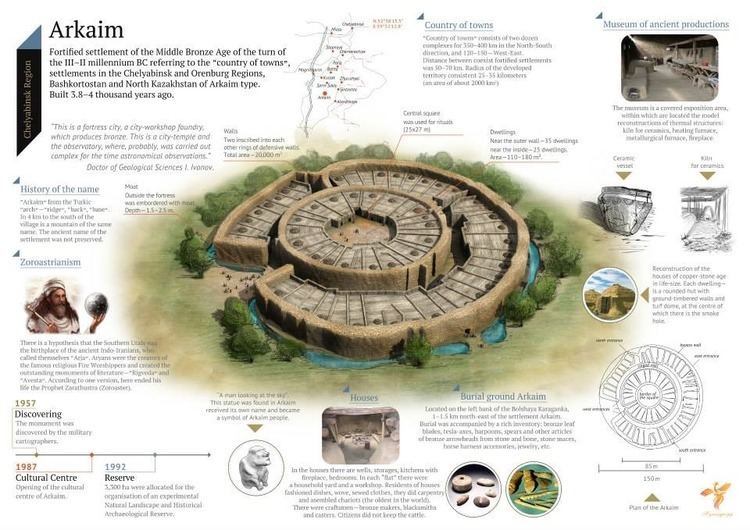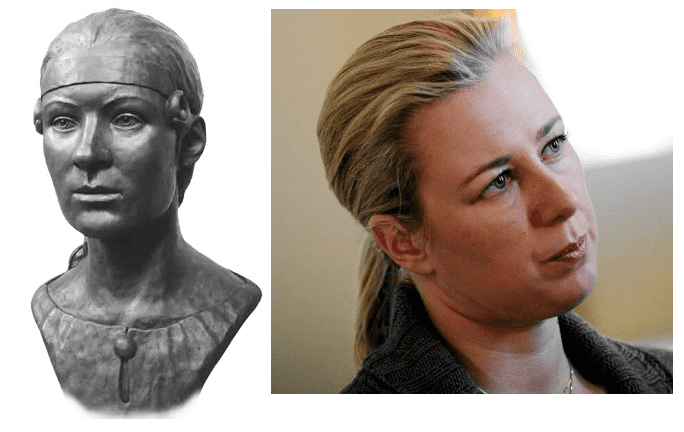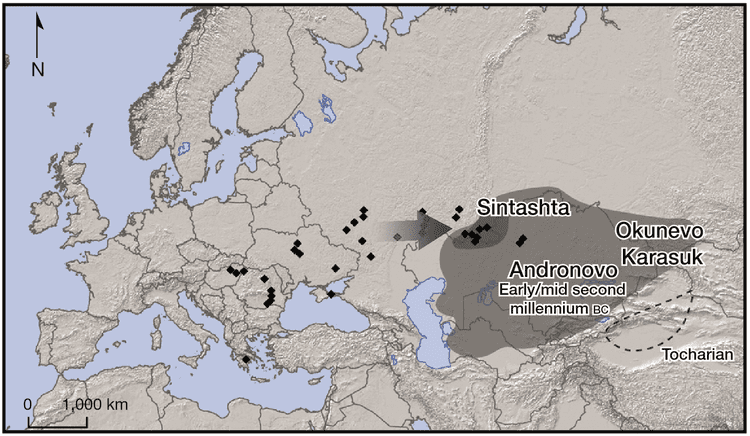Dates 2100–1800 BCE Major sites ArkaimPetrovka | ||
 | ||
Characteristics Extensive copper and bronze metallurgyFortified settlementsElaborate weapon burialsEarliest known chariots Preceded by Similar Gandhara grave culture , Archaeological culture , Slab Grave culture | ||
The Sintashta culture, also known as the Sintashta-Petrovka culture or Sintashta-Arkaim culture, is a Bronze Age archaeological culture of the northern Eurasian steppe on the borders of Eastern Europe and Central Asia, dated to the period 2100–1800 BCE. The culture is named after the Sintashta archaeological site, in Chelyabinsk Oblast, Russia.
Contents
- Predecessors Poltavka culture Abashevo culture Corded Ware culture
- Inter group competition and warfare
- Andronovo culture
- Proto Indo Iranian ethnic and linguistic identity
- Metal production
- References

The Sintashta culture is regarded as the origin of the Indo-Iranian languages. The earliest known chariots have been found in Sintashta burials, and the culture is considered a strong candidate for the origin of the technology, which spread throughout the Old World and played an important role in ancient warfare. Sintashta settlements are also remarkable for the intensity of copper mining and bronze metallurgy carried out there, which is unusual for a steppe culture.

Predecessors: Poltavka culture, Abashevo culture, Corded Ware culture

The Sintashta culture emerged from the interaction of two antecedent cultures, the Poltavka culture and the Abashevo culture. Because of the difficulty of identifying the remains of Sintashta sites beneath those of later settlements, the culture was only recently distinguished from the Andronovo culture. It is now recognised as a separate entity forming part of the 'Andronovo horizon'.

Its immediate predecessor in the Ural-Tobol steppe was the Poltavka culture, an offshoot of the cattle-herding Yamnaya horizon that moved east into the region between 2800 and 2600 BCE. Several Sintashta towns were built over older Poltavka settlements or close to Poltavka cemeteries, and Poltavka motifs are common on Sintashta pottery.
Sintashta material culture also shows the influence of the late Abashevo culture, derived from the Fatyanovo-Balanovo culture, a collection of Corded Ware settlements in the forest steppe zone north of the Sintashta region that were also predominantly pastoralist.
Allentoft et al. (2015) found close autosomal genetic relationship between peoples of Corded Ware culture and Sintashta culture, which "suggests similar genetic sources of the two," and may imply that "the Sintashta derives directly from an eastward migration of Corded Ware peoples." Sintashta individuals and Corded Ware individuals both had a relatively higher ancestry proportion derived from the early farmers of Central Europe, and both differed markedly in such ancestry from the population of the Yamnaya Culture and most individuals of the Poltavka Culture that preceded Sintashta in the same geographic region.
Inter-group competition and warfare
The first Sintashta settlements appeared around 2100 BCE, during a period of climatic change that saw the already arid Kazakh steppe region become even more cold and dry. The marshy lowlands around the Ural and upper Tobol rivers, previously favoured as winter refuges, became increasingly important for survival. Under these pressures both Poltavka and Abashevo herders settled permanently in river valley strongholds, eschewing more defensible hill-top locations.
The Abashevo culture was already marked by endemic intertribal warfare; intensified by ecological stress and competition for resources in the Sintashta period, this drove the construction of fortifications on an unprecedented scale and innovations in military technique such as the invention of the war chariot. Increased competition between tribal groups may also explain the extravagant sacrifices seen in Sintashta burials, as rivals sought to outdo one another in acts of conspicuous consumption analogous to the North American potlatch tradition. Sintashta artefact types such as spearheads, trilobed arrowheads, chisels, and large shaft-hole axes were taken east. Many Sintashta graves are furnished with weapons, although the composite bow associated later with chariotry does not appear. Sintashta sites have produced finds of horn and bone, interpreted as furniture (grips, arrow rests, bow ends, string loops) of bows; there is no indication that the bending parts of these bows included anything other than wood. Arrowheads are also found, made of stone or bone rather than metal. These arrows are short, 50–70 cm long, and the bows themselves may have been correspondingly short.
Andronovo culture
Because of the difficulty of identifying the remains of Sintashta sites beneath those of later settlements, the culture was only recently distinguished from the Andronovo culture. It is now recognised as a separate entity forming part of the 'Andronovo horizon'.
Proto-Indo-Iranian ethnic and linguistic identity
The people of the Sintashta culture are thought to have spoken Proto-Indo-Iranian, the ancestor of the Indo-Iranian language family. This identification is based primarily on similarities between sections of the Rig Veda, an Indian religious text which includes ancient Indo-Iranian hymns recorded in Vedic Sanskrit, with the funerary rituals of the Sintashta culture as revealed by archaeology. There is however linguistic evidence of a list of common Vocabulary between Finno-Ugric and Indo-Iranian Languages. While its origin as a creole of different tribes in the Ural region may make it inaccurate to ascribe the Sintashta culture exclusively to Indo-Iranian ethnicity, interpreting this culture as a blend of two cultures with two distinct languages is a reasonable hypothesis based on the evidence. From the Sintashta culture the Indo-Iranian languages migrated with the Indo-Iranians to Anatolia, India and Iran. From the 9th century BCE onward, Iranian languages also migrated westward with the Scythians back to the Pontic steppe where the Proto-Indo-Europeans came from.
Metal production
The Sintashta economy came to revolve around copper metallurgy. Copper ores from nearby mines (such as Vorovskaya Yama) were taken to Sintashta settlements to be processed into copper and arsenical bronze. This occurred on an industrial scale: all the excavated buildings at the Sintashta sites of Sintashta, Arkaim and Ust'e contained the remains of smelting ovens and slag. Much of this metal was destined for export to the cities of the Bactria–Margiana Archaeological Complex (BMAC) in Central Asia. The metal trade between Sintashta and the BMAC for the first time connected the steppe region to the ancient urban civilisations of the Near East: the empires and city-states of Iran and Mesopotamia provided an almost bottomless market for metals. These trade routes later became the vehicle through which horses, chariots and ultimately Indo-Iranian-speaking people entered the Near East from the steppe.
